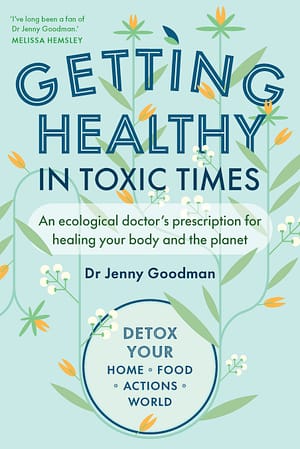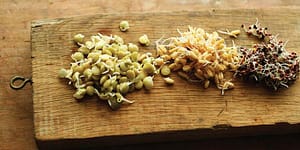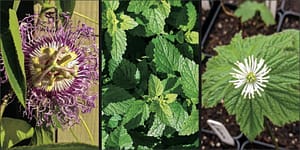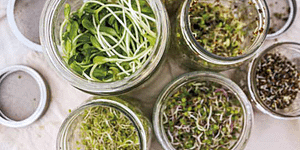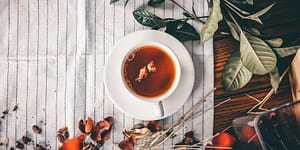Healing Our Bodies, Healing Our Earth

How can we protect ourselves from the pollution, chemicals, and toxins that pervade our environment? Dr. Jenny Goodman connects the health of our planet with our own well-being, addressing the questions that very few doctors ask. Ultimately the goal is to empower you to look after your own health—and that of the planet because “healing our bodies and repairing the earth are one and the same project.”
The following is an excerpt from Getting Healthy in Toxic Times by Jenny Goodman. It has been adapted for the web.
In writing this book, I’ve encountered many wonderful scientists and campaigners. Some are aware of the danger of pesticides and are trying to save us from that. Others are raising the alarm about what fluoride is doing to us or the risks of heavy metal contamination. Still others are warning about the hazards that plastics pose to the planet and to all life upon it. Some are trying to stop the dumping of sewage into our water, some are campaigning for air that is safe for our children to breathe. Some have been researching and writing for decades about the dangers of nuclear power, and others about the greatly underestimated risks that mobile phones, mobile-phone masts, microwaves and wi-fi pose to us and to wildlife. A few scientists have actually noticed and documented the vast increase in cancer, neurodegenerative disease and other illnesses that is resulting from all of this. And this is not just among humans; experienced vets are noticing that our dogs are not living as long as they used to.
Each of these scientists and campaigners is doing a vital job.
Each is holding one piece of the puzzle. It may be impossible, intellectually and emotionally, for anyone to hold The Whole Picture, but something like that is what I’ve attempted, perhaps rashly, to do in this book. It has felt, at times, like living in what Douglas Adams called the Total Perspective Vortex. Yet it’s certainly not complete; there are numerous topics I haven’t had space to cover, such as noise pollution, light pollution or occupational illness from exposure to specific chemicals.
So how do you, dear reader, choose what to do? Take it slowly. The information is yours, now, to do with as you will. Every little helps and each change makes a difference. You don’t need to make all the changes at once! Even with a growing awareness of the overview, you will probably feel drawn to one particular issue more than another. For yourself, the first steps are eating organic, filtering your water, moderating/mitigating your use of mobile phone technology and going through your home with a fine-toothed comb. In terms of campaigning, go where your passion takes you. Pretty well any campaign you might be inspired to join is mentioned in one of the first six chapters.
The Power in You: This is about reclaiming control over our own health.
I have to admit, I don’t particularly like thinking of myself as a ‘consumer’ – the word seems to reduce a human being to just a mouth, endlessly wanting STUFF. But consumer power is real: if we can overcome our shopping addiction and stop buying all these unnecessary toxic products, manufacturers will stop making them. If we support the alternative, safe, natural products, those alternatives will thrive and so will we. In the end it’s about breaking the ‘tyranny of convenience’, and creating new habits, especially in our homes, so home can become again the sanctuary it is meant to be.
Most challengingly, when we find ourselves asking the inevitable question ‘But surely they wouldn’t allow all this stuff to be sold if it was dangerous?’ we need to face up to the answer: yes, they would, and they do. There is no ‘they’ looking after us; companies are just looking after their profits, while governments look the other way. It’s up to us.
But where is the medical profession in all this?
Shouldn’t they – we – be on the frontline of the battle for human health? It has struck me that, of the books I’ve read about the devastating effects of environmental pollution on our health, most have been written by investigative journalists, not medics. There are campaigns to save the whales, the hedgehogs, the bats, the birds, the beetles, tigers, rhinos and rainforests – quite right too. But there is no campaign that I know of to Save the Humans. I guess we imagine that the issue of human health is ‘covered’ by the existence of doctors, hospitals, the NHS – God bless. But they won’t do it for us. They just pick up the pieces. But our species, homo not-very-sapiens, is endangered.
When I ask GPs and other fellow medics what they think are the main environmental determinants of disease and death, they say cigarette smoking and excess alcohol. Those are very important indeed, but not environmental in the sense I mean it in this book. Some of the more aware doctors may add that iatrogenic illness, illness caused by medical treatment, is the fifth leading cause of death in the world. This is mostly due to adverse drug reactions, or ADRs. Perhaps I should have included them in this book; drugs as human poisons. After all, I did mention what those drugs are doing to the fish in our rivers! But space is limited.
Overall, the attitude of the medical profession at large is one of fatalism: ‘Doctor, why has this happened to me? To my body?’ ‘Oh, it’s just bad luck.’ That is an astonishingly common response my patients have had from their GPs or hospital consultants, and it’s remarkably unscientific. Science is supposed to be all about cause and effect. Yet we are not trained, in medical school, to wonder about causes, and thus prevention, of illness.
This fatalism has filtered through to the general public.
So, when someone we love becomes seriously ill, what do we do with the inevitable sadness, despair or rage that follows? We don’t ask why, but we channel our compassion and natural desire to help, to do something, into the outlets our society provides. We wear a pink ribbon, run marathons to raise money, or wear a hat on Wear a Hat Day. I salute the love and caring that are the source of these activities, but I worry.
I worry that the money raised goes to charities that simply fund the research of the drug industry, which is looking for futile but profitable ‘magic bullets’, not at causes. I worry that wearing a pink ribbon does not prevent breast cancer, the causes of which we have seen in this book. And I worry that Wear a Hat Day will not prevent or cure a single brain tumour. But the people in the ads look incredibly cheerful; ecstatic, in fact. And the hats are very cool. I haven’t been able to discover when Wear a Hat Day began, but I’ll bet it was pretty recent. Ten years ago, I knew nobody with a brain tumour. Now, sadly, I know (or know of ) many. Wear a Hat Day is one response to this rapidly increasing incidence. This book is another.
If we attempt to separate ourselves, disaster follows.
All the world’s great spiritual traditions tell us that we are one with nature, with each other, with all beings. From Buddhism in the East to the Native American wisdom of the West, that is the message. The great Vietnamese Buddhist teacher Thích Nhất Hạnh called it ‘interbeing’. We are not separate.
If we get hooked on money and power and ‘stuff’, we lose touch with our mother the earth; we lose the plot. As the Native American botanist Robin Wall Kimmerer puts it: ‘All flourishing is mutual. We need acts of restoration, not only for polluted waters and degraded lands, but also for our relationship to the world.’
When we finally realise that the decline in our loved ones’ health is coming from the self-same causes as the forest fires on the other side of the globe, the same causes as the melting Arctic ice and the drowning tropical islands, the same causes as the missing dawn chorus and the mysteriously withering trees in our own local park – then perhaps we will see that it is all one fight: our right to a healthy life along with that of all our fellow beings on this planet.
Healing our bodies and repairing the earth are one and the same project.
Recommended Reads
Recent Articles
Want to start your own medicinal herb garden? Passionflower, lemon balm, and goldenseal are great places to begin! These herbs are jam-packed with medicinal properties and easy to grow in a majority of climates.
Read MoreSprouts are easy to cultivate, mature quickly and pack a nutritional punch! You can make nutrient-rich sprouts from all kinds of edible seeds in your kitchen.
Read MoreSuffering from frequent headaches is miserable and immobilizing. If you haven’t had luck treating and preventing your headaches, skip the over-the-counter approach and prepare herbal formuals for migraines to use in the future! The following is an excerpt from Herbal Formularies for Health Professionals, Volume 4 by Jill Stansbury. It has been adapted for the…
Read More“It is more important to know what kind of person has a disease than to know what kind of disease a person has.” —Hippocrates Drawing on her decades of clinical experience and her extensive research, Dr. Jill Stansbury offers an unparalleled range of herbal formulas in her five-volume set, Herbal Formularies for Health Professionals. For each…
Read More
